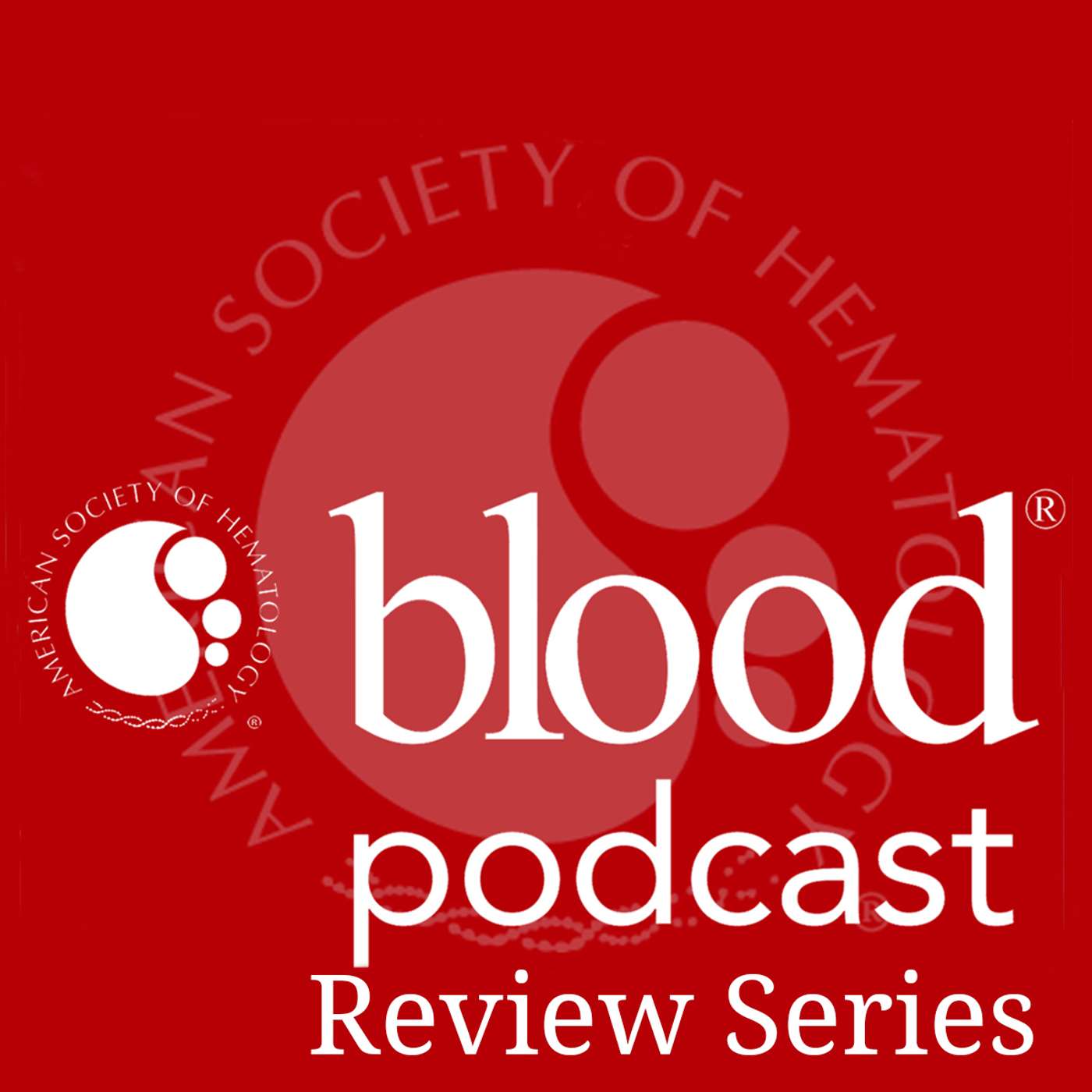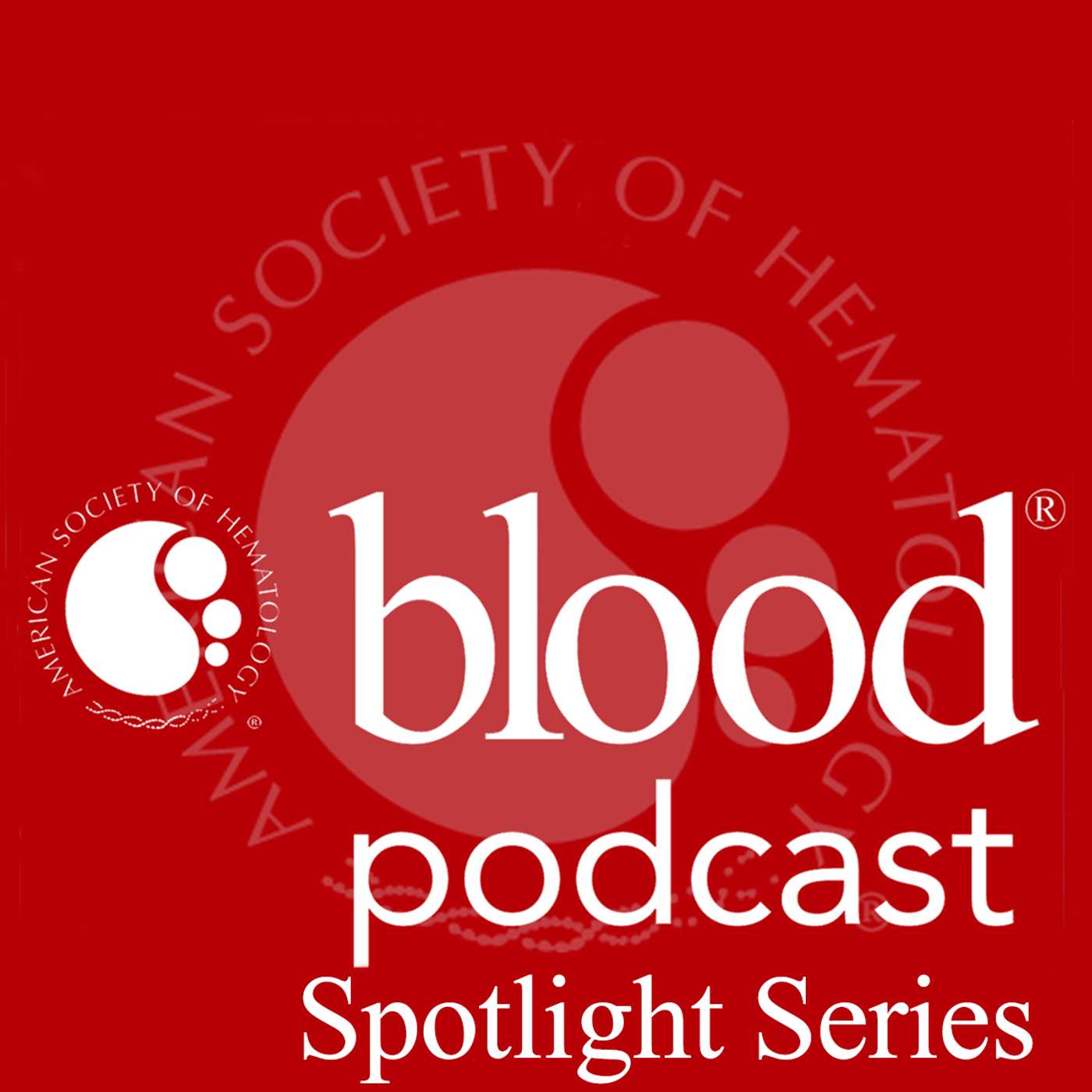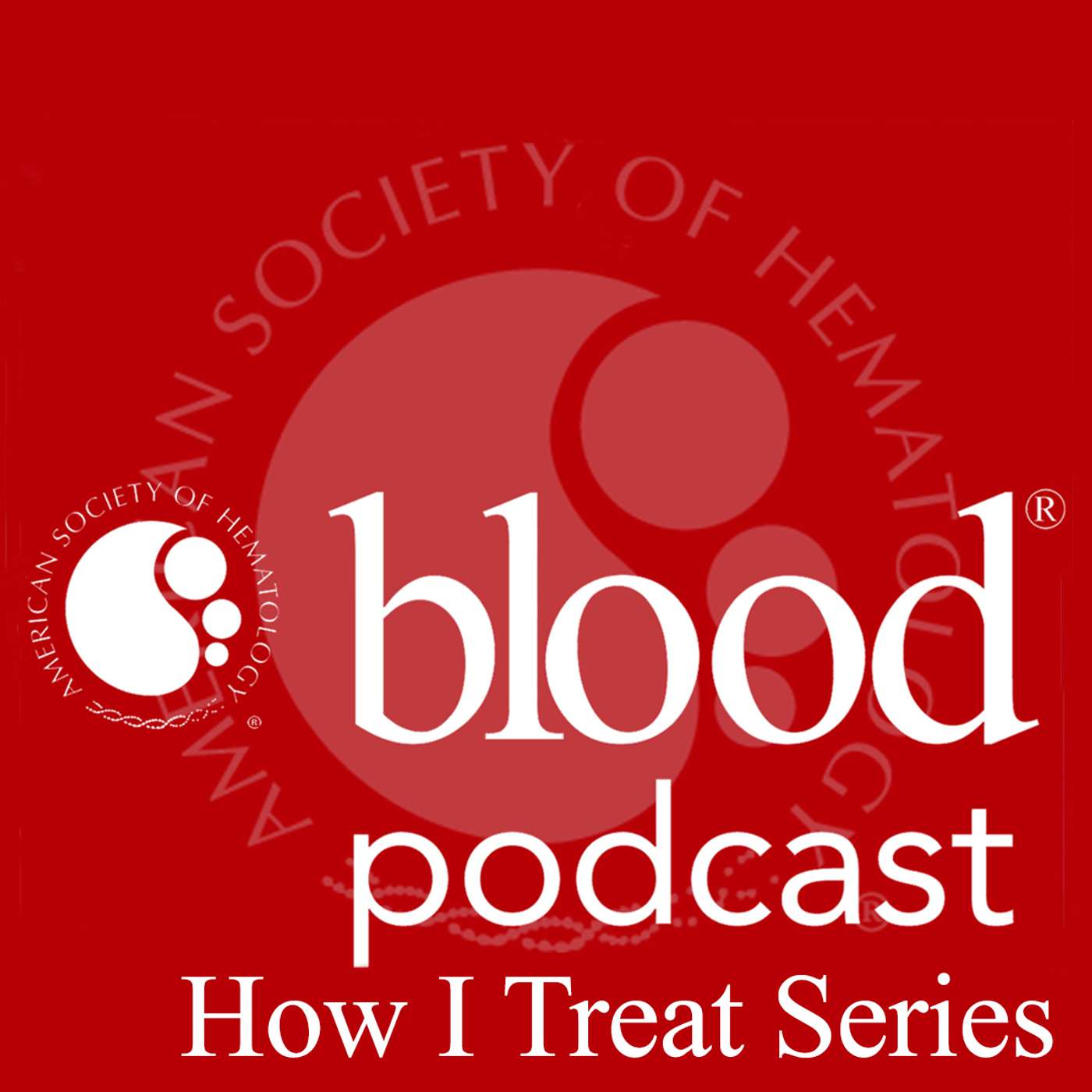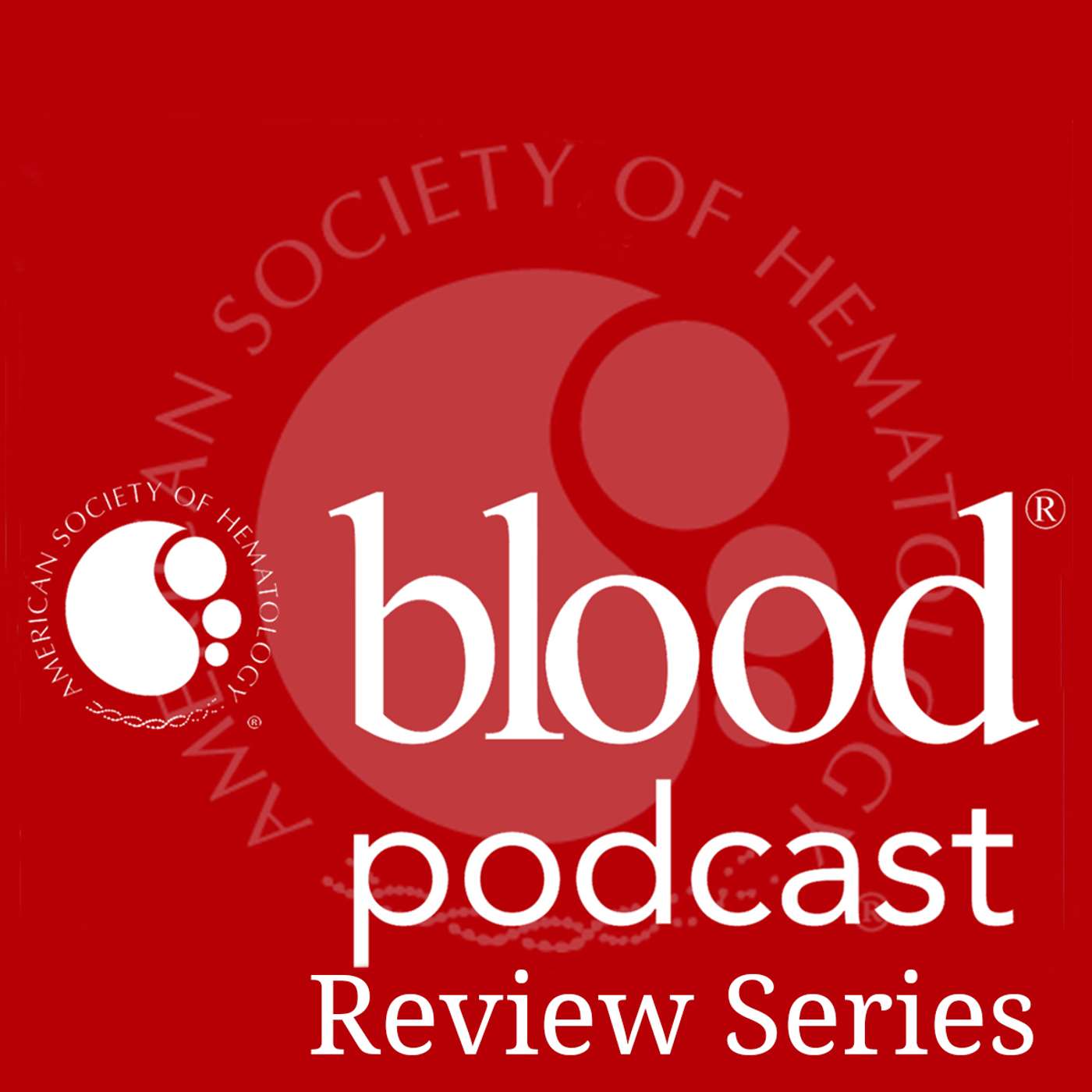Discover Blood Podcast
Blood Podcast

Blood Podcast
Author: American Society of Hematology
Subscribed: 394Played: 12,398Subscribe
Share
© 2026 American Society of Hematology
Description
The Blood Podcast summarizes content recently published in Blood, the most cited peer-reviewed publication in the field of hematology.
361 Episodes
Reverse
This week's episode accompanies the Review Series on Marginal Zone Lymphoma published in this week's issue of Blood. Associate editor, Dr. Philippe Armand interviews authors Dr. Juan Pablo Alderuccio and Dr. Ariela Noy on their contribution to this review series titled "The treatment of marginal zone lymphoma". The article is crucial in highlighting the clinically and biologically heterogenous nature of MZL diseases, and how current treatment options and available research do not allow for comprehensive MZL specific therapies. Drs. Alderuccio and Noy share their insights on specific avenues for the expansion of the MZL care landscape. Find the full review series in volume 147 issue 2 of Blood journal.
In this week's episode we've pulled a vault recording from 2025! Blood editor Dr. Laurie Sehn interviews authors Drs. David-Alexandre Trégouët and Johannes Schetelig on their research published in volume 146 issue 19 of Blood journal. Dr. Trégouët's study conducted a genome-wide association study supplemented by transcriptome and Mendelian randomization analyses to identify 28 loci and proteins associated with VTE recurrence risk. This work provides genomic evidence that inherited variants contribute to the risk of VTE recurrence, raising the possibility of a more personalized approach to the prevention of recurrent VTE. The study conducted by Dr. Schetelig and colleagues report the results of a long term trial on patients with poor-response AML, comparing outcomes between patients who received salvage chemotherapy versus immediate transplantation. With no difference in survival rates at 5 years, outcomes seem to be determined mainly by genetic risk factors, age, and comorbidities, therefore challenging the routine use of intensive remission induction before allogeneic transplant in patients with an available donor and underscore the need for novel therapeutic strategies for poor-risk AML.Featured Articles:Molecular Determinants of Thrombosis Recurrence Risk Across Venous Thromboembolism Subtypes Disease risk but not remission status determines transplant outcomes in AML: long-term outcomes of the ASAP trial
In this week's episode, Blood editor Dr. James Griffin interviews authors Drs. Vincent Muczynski and Mark Geyer on their latest research published in Blood. Dr. Muczynski's research asks if there could there be a better gene than the factor VIII (FVIII) gene to transfer for curative treatment of hemophilia A? Dr. Geyer then explores CAR T cells armed with interleukin-18 (IL-18) secretion that target CD371, a transmembrane glycoprotein with high expression on AML and leukemia-initiating cells. Both studies explore finding novel targets for these powerful treatment modalities. Featured Articles:Alternative AAV gene therapy for hemophilia A using expression of Bi8, a novel single-chain FVIII-mimetic antibodyCD371-targeted CAR T cells secreting interleukin-18 exhibit robust expansion and clear refractory acute myeloid leukemia
In this week's episode, Blood editor Dr. Laurie Sehn interviews three of the latest Blood authors: Drs. Vijay Sankaran, Ruud Delwel, Françoise Kraeber-Bodere. Two studies on the MECOM gene have been paired in this episode, analyzing new groundwork for potential novel myeloid differentiation therapies via repression of MECOM restoring enhancer mediated CEBPA expression. We'll also hear about the results of CASSIOPET, imaging companion study of the CASSIOPEIA trial, and how achieving negativity in PET before starting maintenance therapy is significant even in patients who still show residual disease in the bone marrow.Featured ArticlesCEBPA repression by MECOM blocks differentiation to drive aggressive leukemiasMECOM is a master repressor of myeloid differentiation through dose control of CEBPA in acute myeloid leukemia Prognostic value of premaintenance FDG PET/CT response in patients with newly diagnosed from the CASSIOPEIA trial
In this Review Series episode, Blood Associate Editor, Dr. Elisabeth Battinelli discusses the Platelet Heterogeneity with authors Drs. Craig Morrell, Larry Frelinger, and Leo Nicolai. Find the full review series in volume 146 issue 24 of Blood.
In this special episode, Blood editor Dr. Laura Michaelis interviews Dr. Arielle Langer and Blood Associate editor Dr. Marc Blondon for this special Maternal Health episode. In honor of the second Maternal Health compendium, both discuss their papers featured in this special collection. Featured Articles: β-Thalassemia minor is associated with high rates of worsening anemia in pregnancyLongitudinal profile of estrogen-related thrombotic biomarkers after cessation of combined hormonal contraceptivesSee the entire Maternal Health Compendium Second Edition
In this week's episode, Blood editor Dr. James Griffin speaks with Drs. Emanuele Zucca and Sandra Pinho about their latest articles published in Blood. Dr. Zucca discusses his second analysis of the IELSG37 trial, where findings suggested that R-CHOP21 rituximab, cyclophosphamide,doxorubicin, vincristine, and prednisone, administered every 21 days) may be a suboptimal frontline regimen for PMBCL. Dr. Pinho discusses the aging megakaryocytic niche and its influence on the age-associated decline in HSC and progenitor cell function. The authors demonstrate that remodeling of the megakaryocytic niche and associated platelet factor 4 (PF4) downregulation are central mechanisms driving HSC aging.Featured Articles: Impact of immunochemotherapy regimens on outcomes of patients with primary mediastinal B-cell lymphoma in the IELSG37 trial Platelet Factor 4 (PF4) Regulates Hematopoietic Stem Cell Aging
In this week's episode, Blood editor Dr. Laurie Sehn interviews authors Drs. Lorenzo Falchi and Robert Levy on their latest papers published in Blood Journal. Dr. Falchi discusses his work on an open-label, multicenter phase 1b/2 study evaluating fixed-duration epcoritamab with rituximab and lenalidomide in 108 patients with relapsed or refractory follicular lymphoma. Dr. Levy shares his work on demonstrating that in vivo expansion of Tregs in recipients prior to transplant is possible by activating TNFRSF25 (also known as death receptor 3) in combination with low-dose interleukin-2 in preclinical models. Both papers showed impressive and promising results for the treatment of lymphoma and GVHD.Featured ArticlesFixed-Duration Epcoritamab Plus R2 Drives Favorable Outcomes in Relapsed or Refractory Follicular LymphomaPre-transplant targeting of TNFRSF25 and CD25 stimulates recipient Tregs in target tissues ameliorating GVHD post-HSCT
In this week's episode, Blood editor Dr. Laura Michaelis interviews authors Drs. Terri Parker and Peter Lenting on their latest papers published in Blood Journal. Dr. Lenting discusses his work on introducing a new therapeutic approach to von Willebrand disease with the development of a novel bispecific antibody (KB-V13A12) that links endogenous mouse VWF to albumin, extending VWF half-life twofold with cessation of provoked bleeding. Dr Parker shares the results of a 43-patient phase 2 study that evaluates the single agent isatuximab, a CD38 monoclonal antibody, in patients with relapsed/refractory AL amyloidosis. With a hematological response rate of 77%, organ response rates between 50 and 57%, and an excellent safety profile, the current study lays the foundation for future use of isatuximab across treatment settings and combination strategies.Featured ArticlesIsatuximab for Relapsed and/or Refractory AL Amyloidosis: Results of a Prospective Phase 2 Trial (SWOG S1702)A bispecific nanobody for the treatment of von Willebrand disease type 1
In this week's episode, associate editor Dr. James Griffin interviews researchers Dr. John Semple and Dr. Othman Al-Sawaf on their groundbreaking studies on transfusion-related acute lung injury and chronic lymphocytic leukemia treatment. Dr. Semple explored how mitochondrial DNA could act as a first hit in lung injury, while Dr. Al-Sawaf revealed that patient fitness may not significantly impact the efficacy of targeted CLL treatments. Both studies challenge existing medical assumptions and suggest new approaches to understanding disease mechanisms and treatment responses.Featured ArticlesThe impact of fitness and dose intensity on clinical outcomes with venetoclax-obinutuzumab in CLLMitochondrial DNA via recipient TLR9 acts as a potent first-hit in murine transfusion-related acute lung injury (TRALI)
In this week's episode, Blood editor Dr. Laura Michaelis interviews author Dr. Taylor Brooks on his latest paper published in volume 146 issue 18 of Blood Journal. The conversation discusses outcomes of bispecific antibodies (epcoritamab or glofitamab) in treating aggressive B-cell lymphoma in a study with 245 patients. Findings show a tentative way forward in treatment for patients with relapsed or refractory (R/R) diffuse large B-cell lymphoma (DLBCL).Featured Article:Real-world outcomes of patients with aggressive B-cell lymphoma treated with epcoritamab or glofitamab
In this Review Series episode, Associate Editor Dr. Philippe Armand speaks with multiple authors about what it might look like to improve treatments follicular lymphoma, a disease that has been put on the backburner of innovation due to its generally treatable nature. Dr. Armand discusses "Treatment of relapsed and refractory follicular lymphoma: which treatment for which patient for which line of therapy?" with author Dr. Carla Casulo, "The future of follicular lymphoma management: strategies on the horizon” with author Dr. Sarah C. Rutherford, and "An updated understanding of follicular lymphoma transformation” with Dr. Erin M. Parry.Find the whole review series on follicular lymphoma in volume 146 issue 15 of Blood Journal.
In this week's episode of the Blood Podcast, Associate Editor Dr. James Griffin interviews Drs. Binod Dhakal and Ruben Bierings about their respective papers published in this week's issue of Blood. Dr. Dhakal presents his study on using talquetamab, a bispecific antibody, as a bridging therapy before BCMA-targeted CAR T-cell therapy in multiple myeloma patients, showing promising results with high response rates and manageable toxicities. Next, Dr. Bierings identified patients with genetic variants in the guanine exchange factor MAP kinase–activating death domain (MADD) that impair VWF secretion from endothelial cells and possibly cause VWD type 1. Featured ArticlesA novel cause of type 1 von Willebrand disease: impaired exocytosis of Weibel-Palade bodies due to biallelic MADD variantsSophie Hordijk, Stijn A. Groten, Petra E. Bürgisser, Sebastiaan N. J. Laan, Georg Christoph Korenke, Tomáš Honzík, Diane Beysen, Frank W. G. Leebeek, Paul A. Skehel, Maartje van den Biggelaar, Tom Carter, Ruben BieringsSequential targeting in multiple myeloma: talquetamab, a GPRC5D bispecific antibody, as a bridge to BCMA CAR-T therapyBinod Dhakal, Othman S. Akhtar, David Fandrei, Alexandria Jensen, Rahul Banerjee, Darren Pan, Shambavi Richard, Reed Friend, Matthew Rees, Patrick Costello, Mariola Vazquez Martinez, Oren Pasvolsky, Charlotte Wagner, James A. Davis, Omar Castaneda Puglianini, Ran Reshef, Aimaz Afrough, Danai Dima, Manisha Bhutani, Omar Nadeem, Ricardo Parrondo, Ciara Freeman, Lekha Mikkilineni, Shahzad Raza, Larry D. Anderson Jr, Prashant Kapoor, Hitomi Hosoya, Saurabh Chhabra, Ariel Grajales-Cruz, Mahmoud Gaballa, Shonali Midha, Melissa Alsina, Douglas Sborov, Krina Patel, Yi Lin, Christopher Ferreri, Nico Gagelmann, Anupama Kumar, Doris Hansen, Andrew Cowan, Luciano J. Costa, Maximilian Merz, Surbhi Sidana
In this Spotlight series episode on Acute Myeloid Leukemia, Blood Editor, Dr. Selina Luger interviews Drs. Laura Michaelis and Alexander Perl on their paper in the series titled “The fit older adult with acute myeloid leukemia: clinical challenges to providing evidence-based frontline treatment”. The conversation explores challenges in treating AML across different patient populations. They also focus on treatment approaches for fit older adults with AML, highlighting the need for less toxic therapies and ongoing randomized trials to better understand treatment efficacy. See the full spotlight series on Acute Myeloid Leukemia in Volume 145 Issue 24 of Blood journal.
In this week's episode we’ll learn more about a study comparing busulfan-melphalan with melphalan alone as the conditioning protocol for newly diagnosed, transplant-eligible multiple myeloma; then we will discuss data on how three-dimensional transcriptomics can reveal complex interactions between plasma cells and bone marrow microenvironments.Featured ArticlesHigh-dose busulfan-melphalan vs melphalan and reinforced VRD for newly diagnosed multiple myeloma: a phase 3 GEM trialProfiling the spatial architecture of multiple myeloma in human bone marrow trephine biopsy specimens with spatial transcriptomicsPreclinical advances in glofitamab combinations: a new frontier for non-Hodgkin lymphoma
In this How I Treat podcast episode, Laura Michaelis, MD interviews Sung-Yun Pai, MD about their recently published article in Blood journal "How I treat Wiskott-Alrich syndrome". They highlight recent updates in treatment, including new risk-benefit calculations due to safer treatments and longer follow-ups. Challenges include late diagnosis, lack of well-matched donors, and limited gene therapy availability. They emphasize the importance of early referral to specialized centers and the need for discussions about curative intent therapies, including transplant and gene therapy. The conversation also covers the complexities of gene therapy, such as the need for better conditioning agents and the challenges of achieving full correction in all cell types.
In this week's episode we'll learn about targeting the tissue factor pathway inhibitor with a monoclonal antibody to rebalance HEMOSTASIS in hemophilia A and B. In the phase 3 BASIS trial, the monoclonal antibody marstacimab reduced bleeding events, and was generally well tolerated, with no unanticipated side effects. After that: matched-donor allogeneic CD19 CAR-T for adult B-ALL. Given after allogeneic transplantation, CAR-donor lymphocyte infusion after lymphodepleting chemotherapy was associated with favorable efficacy and a tolerable safety profile. Finally: a new prognostic index for mycosis fungoides and Sézary syndrome. Comprised of four prognostic factors, the “CLIPI” could enable more personalized treatment of cutaneous lymphomas, identifying patients who may benefit from intensified treatment.Featured ArticlesMarstacimab prophylaxis in hemophilia A/B without inhibitors: results from the phase 3 BASIS trialMatched donor allogeneic CAR-T for adult B-ALL: toxicity, efficacy, repeat dosing, and the importance of lymphodepletionA new prognostic index (CLIPI) for advanced cutaneous lymphoma enables precise patient risk stratification
In this week's episode, we’ll learn more about relationships between Epstein-Barr virus genomic variants and human diseases, including hematological malignancies; the presence and timing of somatic GATA1 mutations and their relationship to a Down syndrome-specific form of leukemia; and new definitions for high-risk multiple myeloma that emphasize the presence of two or more high-risk cytogenetic abnormalities.Featured Articles:Association of Epstein-Barr virus genomic alterations with human pathologiesClinical significance of preleukemic somatic GATA1 mutations in children with Down syndromeBiallelic antigen escape is a mechanism of resistance to anti-CD38 antibodies in multiple myeloma
In this Review Series episode, Associate Editor Dr. Hervé Dombret speaks with Dr. Mark Litzow about the latest immunotherapy advances for Acute Lymphoblastic Leukemia (ALL). The discussion highlights innovative treatments like blinatumomab and inotuzumab, which are showing remarkable success in clinical trials, including an 85% three-year survival rate and over 90% complete remission in elderly patients. Researchers are focusing on reducing chemotherapy intensity, developing personalized treatment approaches, and identifying optimal immunotherapy strategies for different ALL subtypes. The conversation underscores a promising shift towards more targeted, less toxic treatments that could significantly improve patient outcomes across various age groups and disease characteristics. These emerging therapies represent a potential paradigm shift in ALL treatment, offering hope for more effective and less aggressive therapeutic interventions.Read Dr. Litzow's paper “Incorporation of immunotherapy into frontline treatment for adults with B-cell precursor acute lymphoblastic leukemia” or find the whole review series on acute lymphoblastic leukemia in volume 145 issue 14 of Blood Journal.
In this week's episode we'll learn about Azacitidine in VEXAS syndrome. Treatment can provide responses in patients with this complex autoinflammatory disorder. But relapse rates were high, so long-term therapy may be required to maintain disease control. After that: A step forward in precision blood matching. High-throughput array genotyping enables extended matching to reduce antibody formation. The results show the potential for reducing harm in regularly transfused patients. Finally, identifying a new vulnerability in TP53-mutated AML. Loss of the tumor suppressor BAP1 defines a unique subtype of TP53-mutated de novo AML. BAP1 loss also confers sensitivity to BCL-xL inhibitors in vivo, opening a new therapeutic avenue.Featured ArticlesEfficacy and safety of azacitidine for VEXAS syndrome: a large-scale retrospective study from FRENVEXArray genotyping of transfusion-relevant blood cell antigens in 6946 ancestrally diverse study participantsLoss of BAP1 defines a unique subtype of TP53-mutated de novo AML and confers sensitivity to BCL-xL inhibitors








